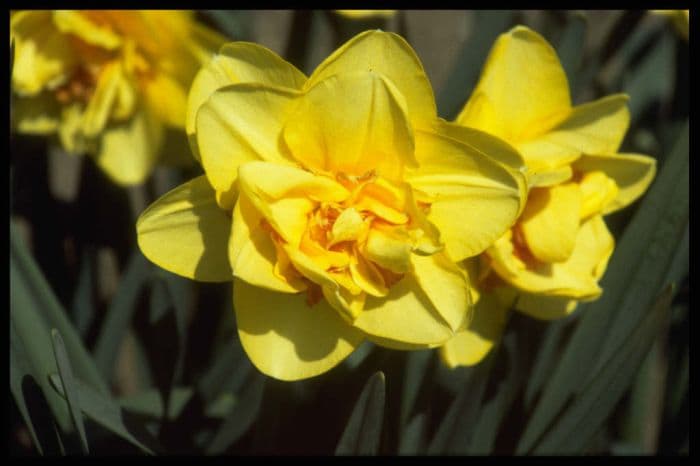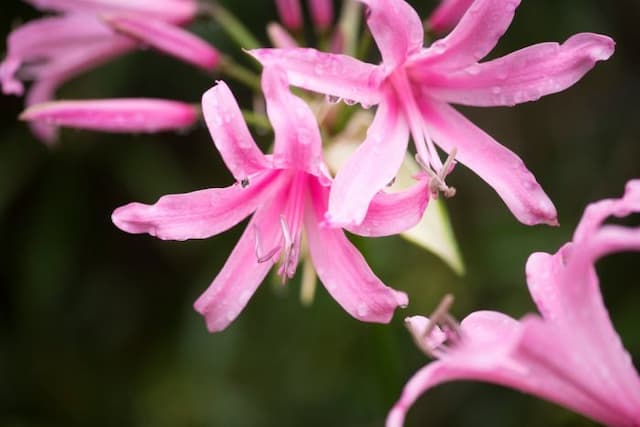Double Daffodil Narcissus 'Tahiti' (4)

ABOUT
Narcissus 'Tahiti' is a captivating variety of daffodil that presents a striking appearance. Its blossoms are double, showcasing an opulent display of golden-yellow petals. The petals are arranged in a frilly, multi-layered fashion, giving the flowers a lush, full look. The most distinctive feature of 'Tahiti' blooms is the contrasting orange segments that adorn the flower's center, providing a bold color contrast that is eye-catching. These vibrant orange segments are nestled among the softer yellow petals, creating an effect reminiscent of a sunny, tropical tableau. The foliage of the Narcissus 'Tahiti' plant consists of long, dark green leaves that are strap-shaped, arching gracefully from the base of the stem. The leaves create an attractive backdrop for the flamboyant flowers, emphasizing their bright colors and ornate petal arrangement. Overall, the allure of Narcissus 'Tahiti' lies in its cheerful, sunny blossoms that bring a touch of tropical exuberance to temperate gardens.
About this plant
 Names
NamesFamily
Amaryllidaceae
Synonyms
Double Daffodil, Tahiti Daffodil, Double Narcissus
Common names
Narcissus 'Tahiti'
 Toxicity
ToxicityTo humans
The Narcissus 'Tahiti', commonly known as the double daffodil, is considered toxic to humans. All parts of the plant contain lycorine and other alkaloids that can cause poisoning if ingested. Symptoms from ingesting parts of the double daffodil can include nausea, vomiting, abdominal pain, and diarrhea. In severe cases, ingestion can lead to cardiac arrhythmias, low blood pressure, tremors, convulsions, and, in rare instances, can be fatal if a significant amount is consumed.
To pets
In pets, particularly dogs and cats, the double daffodil is also toxic. Just like in humans, all parts of the plant contain toxic alkaloids like lycorine. If a pet ingests any part of the double daffodil, symptoms can include vomiting, diarrhea, abdominal pain, excessive drooling, and in some cases, even more severe reactions such as respiratory depression, abnormal heart rates, or seizures. It is important to get veterinary care immediately if you suspect that your pet has eaten any part of the double daffodil.
 Characteristics
CharacteristicsLife cycle
Perennials
Foliage type
Deciduous
Color of leaves
Green
Flower color
Yellow
Height
1-2 feet (30-60 cm)
Spread
0.5-1 feet (15-30 cm)
Plant type
Bulb
Hardiness zones
3-9
Native area
Europe
Benefits
 General Benefits
General Benefits- Aesthetic Appeal: The double flowers of Narcissus 'Tahiti' with their vibrant yellow petals and orange-red centers provide a striking visual for any garden.
- Easy to Grow: Narcissus 'Tahiti' is relatively low maintenance, tolerant of a range of soil types, and requires minimal care once established.
- Spring Bloomer: It heralds the arrival of spring with its early flowering, brightening gardens after the winter months.
- Perennial Growth: As a perennial, it returns year after year, offering a long-term addition to the garden.
- Wildlife Attraction: The bright flowers attract pollinators like bees, benefiting the ecological balance of the garden environment.
- Cut Flower Potential: Sturdy and long-lasting, they make excellent cut flowers for vases and floral arrangements.
- Deer and Rodent Resistant: Narcissus 'Tahiti' has a natural resistance to deer and rodents, making it a good choice for an undisturbed garden.
- Low Disease Susceptibility: It's less prone to common plant diseases that affect many other garden plants, reducing the need for chemical treatments.
 Medical Properties
Medical PropertiesThis plant is not used for medical purposes.
 Air-purifying Qualities
Air-purifying QualitiesThis plant is not specifically known for air purifying qualities.
 Other Uses
Other Uses- Cut flowers: Narcissus 'Tahiti' is often used in floral arrangements due to its bright, double flowers and long vase life, which can bring a cheerful atmosphere to indoor settings.
- Photography subject: The striking appearance of Narcissus 'Tahiti' makes it a favorite among photographers, particularly in springtime garden shoots and botanical art.
- Scented gardens: Narcissus 'Tahiti' is known for its pleasant fragrance, making it a valuable addition to sensory gardens where scent plays a prominent role.
- Wedding decor: The blooms of Narcissus 'Tahiti' are sometimes used in spring wedding bouquets or as table decorations for their sunny and warm appearance.
- Educational tool: In schools or botanical gardens, Narcissus 'Tahiti' can be used to teach students about bulbous plants and their life cycles.
- Cultural events: In areas where spring festivals are celebrated, such as at Easter, Narcissus 'Tahiti' may be used for decoration due to its seasonal bloom time.
- Creative crafts: The flowers of Narcissus 'Tahiti' can be used in crafts, such as making homemade greeting cards or pressed flower art.
- Garden design: Due to its vibrant colors and form, Narcissus 'Tahiti' can be planted to create striking patterns or color blocks in landscape designs.
- Perfume production: Although not a primary use, the essence of Narcissus 'Tahiti' flowers may be extracted and used in creating custom perfumes or scented oils for small-scale or artisanal production.
- Botanical illustration: As a subject for botanical illustrators, Narcissus 'Tahiti' provides complexity with its doubled petals, inspiring detailed artwork.
Interesting Facts
 Feng Shui
Feng ShuiThe Daffodil is not used in Feng Shui practice.
 Zodiac Sign Compitability
Zodiac Sign CompitabilityThe Daffodil is not used in astrology practice.
 Plant Symbolism
Plant Symbolism- Rebirth and New Beginnings: The Narcissus 'Tahiti', commonly known as the Double Daffodil, typically blooms in early spring, making it a symbol of renewal and the start of a new cycle.
- Prosperity: In some cultures, daffodils are seen as bringing good fortune and are associated with wealth and success due to their vibrant and abundant blossoms.
- Unrequited Love: The myth of Narcissus, who fell in love with his own reflection, ties the daffodil to themes of unreturned affection and self-love.
- Regard and Esteem: Giving someone daffodils can express respect and high regard, making it a flower suited to honor others.
 Water
WaterDaffodils, including the Narcissus 'Tahiti', should be watered thoroughly at planting and then moderately when in growth if the weather is dry. Watering once a week with about 1 inch of water (roughly 0.6 gallons per square yard) is usually sufficient, but this can vary depending on soil type and climate conditions. Overwatering should be avoided as daffodils prefer well-drained soil and too much water can lead to bulb rot. During dormant periods, after the foliage has died back, watering should be reduced significantly or stopped altogether.
 Light
LightDaffodils like Narcissus 'Tahiti' thrive in full to partial sunlight. They do best with at least 6 hours of direct sunlight daily; therefore, an east or south-facing garden bed is ideal for maximum bloom. If grown indoors, a sunny windowsill where the plant can get plenty of bright, indirect light is suitable. Limited light may result in weaker stems and fewer flowers.
 Temperature
TemperatureThe Narcissus 'Tahiti' prefers moderate temperatures, thriving in zones 3 to 8. The ideal temperature range for daffodils is between 50°F and 70°F. They can tolerate minimum winter temperatures down to about -40°F and should not be exposed to temperatures above 80°F for prolonged periods.
 Pruning
PruningPruning Narcissus 'Tahiti' is mostly about removing spent flower heads to prevent seed development, which can be done as soon as the flowers fade. Leave the foliage intact until it has yellowed and withered, which is typically 6 weeks after flowering; this allows the bulbs to store energy for next year’s bloom. Pruning of leaves or stems should not be done immediately after flowering, as this can weaken the bulb.
 Cleaning
CleaningNot needed
 Soil
SoilDouble Daffodil 'Tahiti' prefers well-draining soil with a slightly acidic to neutral pH, ideally between 6.0 and 7.0. To create the best soil mix, combine two parts loam with one part sand or perlite to improve drainage and one part peat or compost to retain adequate moisture without waterlogging.
 Repotting
RepottingDouble Daffodils, including 'Tahiti', do not typically require frequent repotting and should be repotted every 3-5 years. They can be left undisturbed for several years as they prefer to grow in clumps.
 Humidity & Misting
Humidity & MistingDouble Daffodil 'Tahiti' is tolerant of most humidity levels found in outdoor environments and does not require specific humidity conditions, making it versatile for various garden settings.
 Suitable locations
Suitable locationsIndoor
Place 'Tahiti' in a bright spot with some direct sun.
Outdoor
Plant 'Tahiti' in full sun or partial shade.
Hardiness zone
3-9 USDA
 Life cycle
Life cycleThe life of the Narcissus 'Tahiti', commonly known as Double Daffodil, begins with a dormant bulb which starts to grow roots and shoots in response to cooling temperatures in autumn. Leaves and stems emerge from the bulb in late winter to early spring, followed by the development of distinctive double flowers, characterized by multiple rows of yellow petals with orange segments at the center. After blooming, which typically occurs in mid to late spring, the plant enters a period of photosynthesis where the foliage gathers energy and stores it in the bulb. Once the leaves yellow and die back, the daffodil enters summer dormancy. The bulb remains dormant through the hot summer months until the cycle begins anew with the next cooling season. Bulbs can be divided and replanted during the dormant period to propagate new plants.
 Propogation
PropogationPropogation time
Spring-Early Summer
Propogation: The Narcissus 'Tahiti', commonly known as the Double Daffodil, is typically propagated through division of its bulbs. The best time for this process is in late summer to early fall, after the foliage has died back but well before the ground freezes. To propagate, gently lift the clump of bulbs from the ground using a garden fork, taking care not to damage them. Separate the bulbs by gently pulling apart the offsets from the mother bulb. Each offset must have a portion of the base plate to ensure it will grow. The separated bulbs should then be planted immediately at a depth of about 6 inches (about 15 centimeters) and a distance of 6 inches apart to allow room for growth. They will establish roots before winter and burst into growth come spring.









